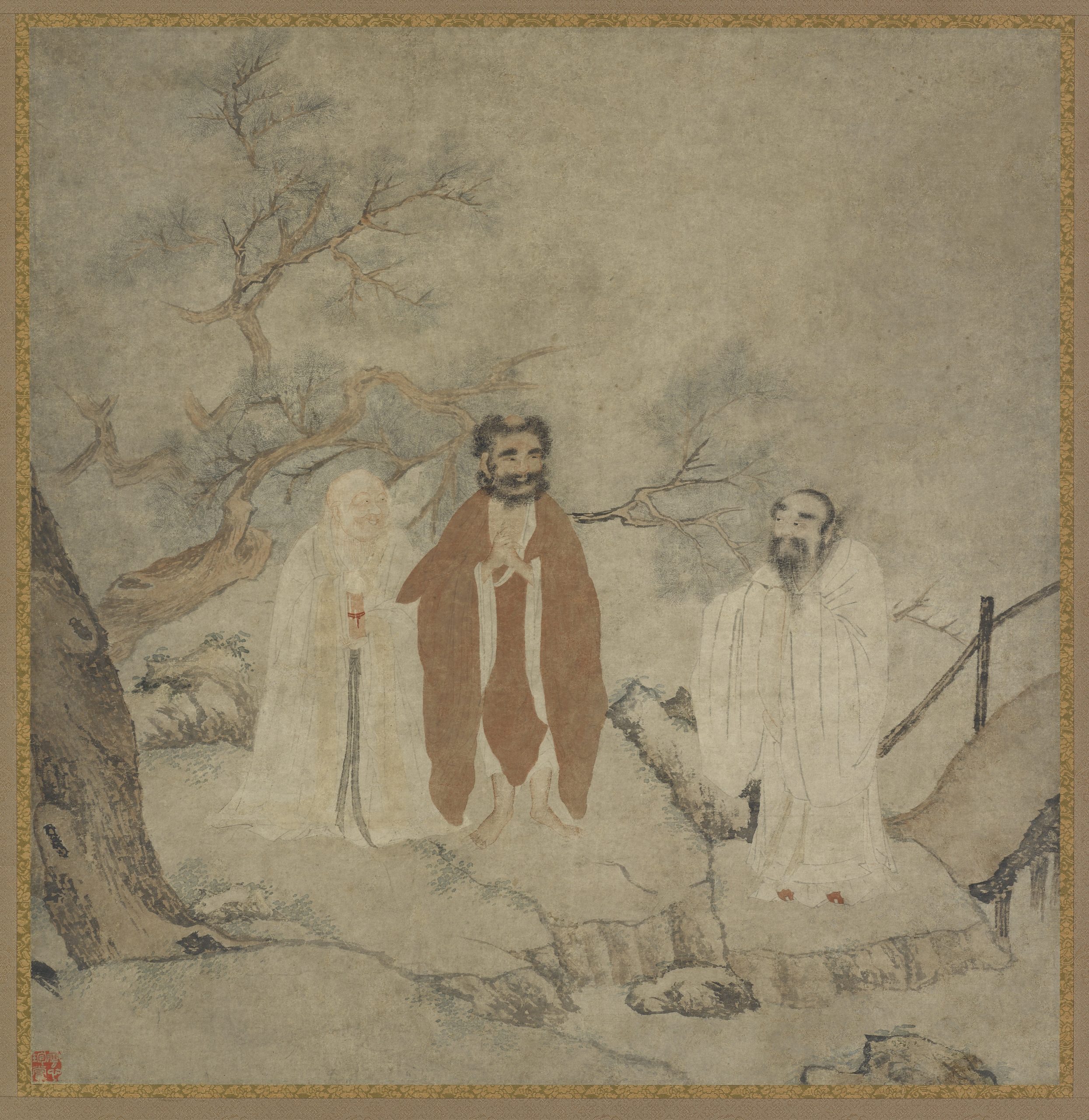The painting shows a gathering underneath a pine tree next to a bridge. Reading from left to right, the three figures are: Laozi(l-ow-dzuh) lao (“old”) and zi (“master”); according to Chinese sources, an extraordinary thinker who flourished during the sixth century BCE. According to some modern scholars, however, Laozi is a legend and never actually existed., founder of Daoism(dow-ihz-uhm) a philosophy based on the ideas of the Chinese thinker Laozi, who taught that people should be guided by a universal force called the Dao (Way).; Siddhartha Gautama(sihd-dahr-tuh gaw-tuh-muh) the given name of Shakyamuni, literally “Sage of the Shakya Clan,” the Historical Buddha. He lived in northeastern India sometime after the fifth century BCE. (also known as Shakyamuni(Shah-kya-moo-knee) literally, “Sage of the Shakya Clan”; the Historical Buddha. His given name was Siddhartha (sid-har-ta) Gautama. He lived in northeastern India sometime after the fifth century BCE.), founder of Buddhism(bood-ihz-uhm) a widespread Asian religion or philosophy founded by Siddartha Gautama in northeastern India in the 5th century BCE.; and Confucius, founder of Confucianisma system of ethical and philosophical teaching associated with the Chinese philosopher Confucius (551–479 BCE). He developed a system of thought that stressed the importance of good government, social order, and harmonious and moral living.. Confucius approaches from the right, folding his hands in a bow to Shakyamuni, the Historical Buddha(bood-huh) literally, “Awakened One”; a being who has awakened to the true reality of existence and is thereby liberated from the cycle of birth, death, and rebirth. A Buddha teaches others the path to Enlightenment.. Shakyamuni, barefooted, wears a red robe. He can be easily identified by his ushnisha, a cranial bump that symbolizes wisdom. Laozi stands behind Shakyamuni and looks at him with a happy smile. He holds a roll of book in his hands, most likely his Daodejing (The Classic of the Way and Virtue).
The compositionthe arrangement of elements in an artwork. of the painting seems to have borrowed from depictions of The Three Laughers at Tiger Creek, a popular allegorical story about the meeting of three famous figures. The Buddhist monk Huiyuan(hway-yoo-en) (334–416) lived in a temple as a recluse and had vowed to never cross the stone bridge over Tiger Creek. One day, the Confucian poet Tao Yuanming(t-ow yoo-en-ming) (365–427) and the Daoist philosopher Lu Xiujing(loo shee-oh-jing) (406–477) came to visit Huiyuan. The three men became so deeply absorbed in conversation that when Huiyuan eventually walked with his friends to say farewell, he crossed the bridge without noticing he had done so. Hence, the three men laughed together, signifying the harmony among the three main religions of the time. The artist of this painting has cleverly replaced the three historical figures with the three spiritual founders.
Confucianism and Daoism are the two great indigenous philosophical traditions of China. Confucianism became accepted as state ideology in the Han dynastya series of rulers from a single family. (206 BCE–220 CE). Daoism came to the fore as a popular belief system around the same time. Meanwhile, Buddhism was introduced to China from India. The three beliefs have since then both conflicted with and complemented each other. The actual blending of the three philosophies did not begin until the tenth century. During the Ming dynasty (1368–1644), when this painting was created, the harmony among the three faiths became a prevalent thought.





